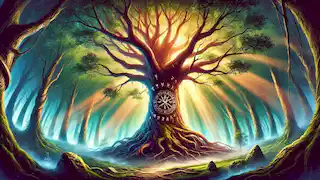<_img-Intro}}}
In the heart of Norse mythology, there stands a tree unlike any other—a tree that binds the cosmos together, whose roots and branches stretch across the nine worlds. This is Yggdrasil, the World Tree, a towering ash that connects all realms and holds the fate of gods and men alike within its sacred wood. Yggdrasil is not just a tree; it is a symbol of life, death, and rebirth, the eternal cycle that governs the universe.
The Origins of Yggdrasil
Long before the gods of Asgard claimed their thrones, when the universe was still in its infancy, Yggdrasil sprouted from the primal void of Ginnungagap. It was nurtured by the first dew that fell from the realm of ice, Niflheim, and the heat that rose from the fiery Muspelheim. These opposing forces of cold and heat combined to give birth to the great World Tree, whose branches would eventually span the entire cosmos.
Yggdrasil’s roots dug deep into the fabric of the universe, anchoring the nine worlds that would form the Norse cosmos. Each root extended to a different realm: one to Asgard, the home of the gods; another to Midgard, the world of men; and yet another to Helheim, the realm of the dead. These roots drew sustenance from the wells at the base of each realm, and from these wells came the wisdom, knowledge, and magic that flowed through all existence.
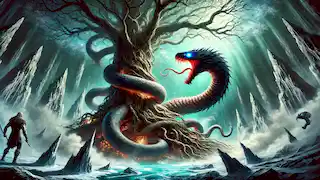
The Creatures of Yggdrasil
Yggdrasil was more than just a tree; it was a living ecosystem, home to a myriad of creatures that played crucial roles in the balance of the universe. At the base of the tree, in the well of Hvergelmir in Niflheim, dwelled Nidhogg, a monstrous serpent that gnawed at the roots of Yggdrasil. Nidhogg’s eternal hunger was a reminder that even the most sacred entities could face destruction.
In contrast, high above in the branches of Yggdrasil, an eagle with piercing eyes sat vigil, watching over the worlds below. This eagle was a symbol of wisdom and foresight, ever aware of the events unfolding in the realms. Perched between the eagle’s eyes was a hawk named Vedrfolnir, swift and sharp, ready to deliver messages from the heavens.
But Yggdrasil also had its defenders. The most notable among them was Ratatoskr, a mischievous squirrel who darted up and down the trunk of the tree, carrying messages between the eagle and Nidhogg. Though his words often stirred tension between the two, Ratatoskr played a crucial role in maintaining the balance, for without conflict, there could be no growth.
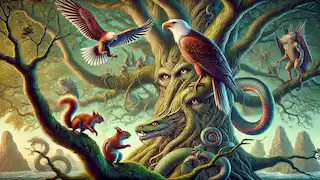
The Realms of Yggdrasil
Yggdrasil’s branches and roots supported the nine worlds of Norse mythology, each with its own unique landscape and inhabitants. Asgard, the realm of the gods, lay high among the branches, bathed in the golden light of divine power. Here, Odin, the Allfather, ruled alongside his fellow Aesir, maintaining order across the cosmos.
Midgard, the realm of humans, was nestled in the middle branches of Yggdrasil. It was a place of struggle and growth, where mortals lived their brief lives, unaware of the greater forces that shaped their destinies. Yet, Midgard was also connected to Asgard by the Bifrost, the rainbow bridge, allowing the gods to interact with and protect humanity.
Far below, in the cold and shadowy roots of Yggdrasil, lay Helheim, the realm of the dead. Ruled by Hel, the daughter of Loki, this realm was a place of darkness and despair. The dead who were not chosen for Valhalla or Folkvangr would find their eternal rest here, under the watchful eye of Hel.
Each realm was a reflection of the cosmic forces that shaped the universe, and Yggdrasil was the axis that held them all in balance.
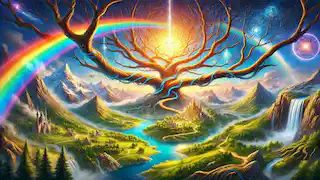
Ragnarok and the Fate of Yggdrasil
Despite its grandeur and power, even Yggdrasil was not immune to the forces of fate. The prophecies of Ragnarok, the end of the world, foretold a time when the gods would fall, and Yggdrasil itself would tremble. As the final battle approached, the tree began to show signs of decay. Nidhogg’s gnawing grew more frantic, and the eagle’s gaze turned somber as the shadows of doom spread across the worlds.
When the fires of Muspelheim, led by the giant Surtr, began to consume the cosmos, Yggdrasil shook violently. The roots that connected the realms weakened, and the branches that once held the worlds together began to crack. The skies darkened as the sun and moon were devoured by wolves, and the sea rose as the Midgard Serpent, Jormungandr, emerged from the depths, ready to face its fate.
In the midst of this chaos, the gods and their enemies clashed in a battle that would determine the fate of all creation. Odin fell to Fenrir, the great wolf, and Thor perished after slaying Jormungandr. As the gods met their end, Yggdrasil, too, began to wither, its life force drained by the devastation around it.
Yet, even in the face of destruction, Yggdrasil’s role as the World Tree endured. From its ashes, a new world would be born, just as it had emerged from the void at the dawn of time.
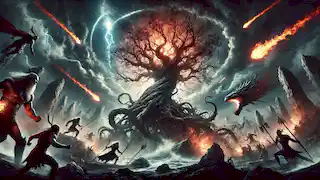
The Rebirth of Yggdrasil
As the flames of Ragnarok consumed the old world, Yggdrasil’s essence persisted, waiting for the right moment to bloom once more. In the aftermath of the great battle, when the fires had subsided and the waters had receded, a new dawn broke over the cosmos. From the remnants of the old world, new life began to stir.
The surviving gods, led by Baldr and Hod, emerged from the ruins to rebuild what had been lost. With them came Lif and Lifthrasir, the last humans, who had taken refuge in Yggdrasil’s sheltering branches during the cataclysm. They carried with them the seeds of a new world, a world that would rise from the ashes of the old.
Yggdrasil, though scarred and battered, began to regrow. Its roots delved deep into the renewed earth, and its branches reached out to the reborn heavens. The tree once again became the axis of the universe, connecting the realms of gods and men, life and death, order and chaos.
As the new world took shape, Yggdrasil stood tall, a symbol of resilience and continuity. The cycle of life, death, and rebirth that it embodied was unbroken, and the cosmos began its eternal dance once more.
Epilogue: The Eternal Tree
The tale of Yggdrasil is not just a story of creation and destruction; it is a reflection of the eternal cycle that governs all existence. The World Tree stands as a reminder that even in the face of inevitable destruction, there is always the promise of renewal. Just as Yggdrasil was reborn after Ragnarok, so too does life continue after every end.
In the hearts of those who remember the old ways, Yggdrasil lives on, its branches reaching out to the infinite sky, its roots anchoring the deepest mysteries of the universe. It is the bridge between the past and the future, the living testament to the resilience of the cosmos.
The tale of Yggdrasil is the tale of existence itself—a journey through creation, destruction, and rebirth, where every ending is but a new beginning.
